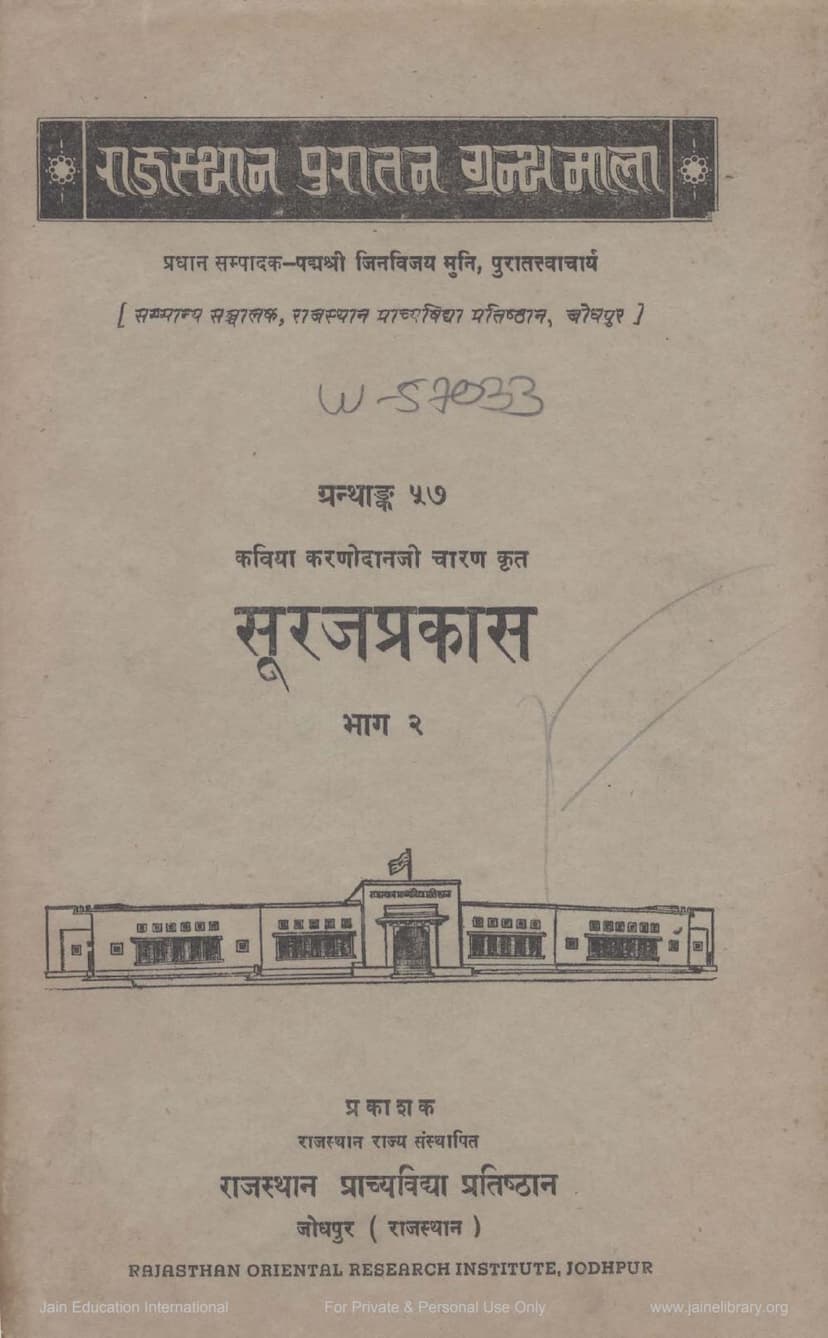Surajprakas Part 02
Added to library: September 2, 2025

Summary
This volume, "Surajprakas Part 02," is the second part of a historical work compiled by Charan Karani Danji, a poet in the court of Maharaja Abhay Singh of Marwar. Published by the Rajasthan Prachyavidya Pratishthan in Jodhpur in 1962, it is part of the "Rajasthan Puratan Granthamala" series. The editor for this specific volume is Sitaram Lalas, renowned for his "Vrihat Rajasthani Shabdkosh" (Comprehensive Rajasthani Dictionary).
The preface highlights that the first volume focused on earlier periods, and this second volume delves into the reigns of Maharaja Gaj Singh, Jaswant Singh, Ajit Singh, and Abhay Singh of Jodhpur. It promises to reveal new historical facts and shed light on the reasons behind the Battle of Ahmedabad between Maharaja Abhay Singh and Sarbuland Khan. The preface also commends the editor, Sitaram Lalas, for his meticulous work and expresses gratitude to the Indian government's Ministry of Scientific and Cultural Affairs for their financial support under the Modern Indian Language Development Scheme.
The table of contents reveals a detailed chronological account of significant events and rulers:
- Chapter 4: Maharaja Gaj Singh: Describes his accession to the throne in Burhanpur after his father's death, his coronation by Daulat Khan, his military campaigns in the south against Amar Champu, his victories, the expansion of the Mughal empire's influence, and his honorable treatment by the Emperor. It also mentions his return to Marwar and his further service to the Emperor.
- Chapter 5: Rao Amar Singh and Maharaja Jaswant Singh:
- Rao Amar Singh: Details his bravery and pride, including the incident at the Mughal court where he killed Salabat Khan for an insult. It recounts his defiance of the Emperor and his eventual death in battle, with his queens performing Sati.
- Maharaja Jaswant Singh (I): Discusses his reign as a shrewd strategist and scholar who defended Hinduism. It recounts his involvement in the Mughal succession struggle, his battles against Aurangzeb's forces, his eventual return to Delhi, his respectful treatment by Aurangzeb despite the Emperor's hidden intentions, his patronage of poets, and his eventual demise in Kabul.
- Chapter 6: Maharaja Ajit Singh: Chronicles his birth while his father Maharaja Jaswant Singh was in Kabul, the demise of his younger brother Dal-Thambhan, his clandestine upbringing, the loyalty of the Rathore chieftains who protected him, and the tragic sacrifice of his mothers to save him. It details his struggle to regain Marwar, the Mughal invasions, the rebellion of Rathores against the Mughals, his eventual rise to power, his marriage alliances, his skirmishes with Mughal forces, the liberation of Marwar from Mughal control, his religious reforms in the capital, and his interactions and conflicts with Emperor Bahadur Shah and the Sayyid brothers. It further narrates his political maneuvering, his alliance with Rana Amar Singh of Udaipur, his victories over Mughal forces, his reinstatement of Amber's king, and the subsequent treaty with Emperor Bahadur Shah. The chapter also covers his involvement in the power struggles following Bahadur Shah's death, his role in the Sayyid brothers' rise and fall, and his eventual death.
- Chapter 7: Maharaja Abhay Singh: Describes his coronation in Delhi by Emperor Muhammad Shah, his triumphant return to Marwar, the joyous welcome by the public, his subsequent campaign against and conquest of Nagaur, his brother Bakht Singh's appointment as king of Nagaur, and his father's death. The text then moves to his significant intervention in Gujarat against Sarbuland Khan. It details the Emperor's summoning of Abhay Singh, the imperial bestowal of governorship of Ajmer and Gujarat upon him, his preparations for the campaign, including gathering his loyal chieftains and making extensive arrangements for his army. The narrative then leads into the preparations for war against Sarbuland Khan, including descriptions of the army's composition, the mobilization of elephants, horses, and weapons.
The text also includes a detailed "Granth-Sar" (Summary of the Text) which provides a narrative of the events covered in Chapter 4 onwards. The summary highlights Maharaja Gaj Singh's coronation, his victories in the south, his recognition by the Emperor, and his skills as a warrior and philanthropist. It then moves to Rao Amar Singh's valor and tragic end, Maharaja Jaswant Singh's political acumen and participation in the Mughal civil wars, and his scholarly pursuits. The summary extensively covers Maharaja Ajit Singh's tumultuous life, his struggle against the Mughals, his alliance with various Rajput rulers, his military campaigns, and his pivotal role in the Delhi politics during the Mughal succession wars. Finally, it details Maharaja Abhay Singh's coronation, his conquest of Nagaur, and the crucial campaign against Sarbuland Khan in Gujarat, emphasizing the meticulous preparations for this significant conflict.
The book also contains appendices listing various terms related to music and dance, special weapons, clothing, and jewelry, indicating a comprehensive approach to historical documentation. The inclusion of a list of " सहायक ग्रंथों की सूची" (List of Supporting Texts) further underscores the scholarly and research-oriented nature of this publication.